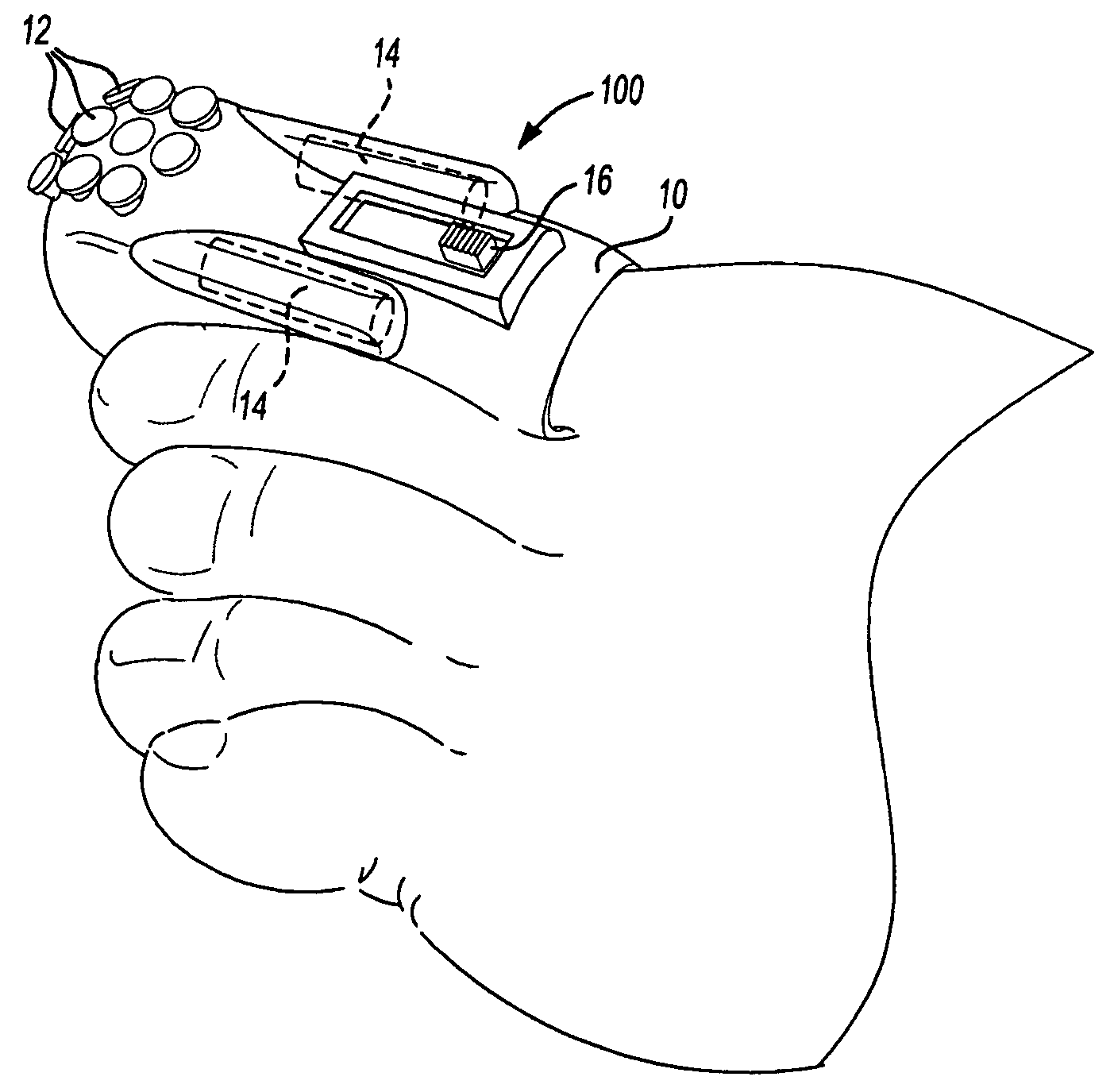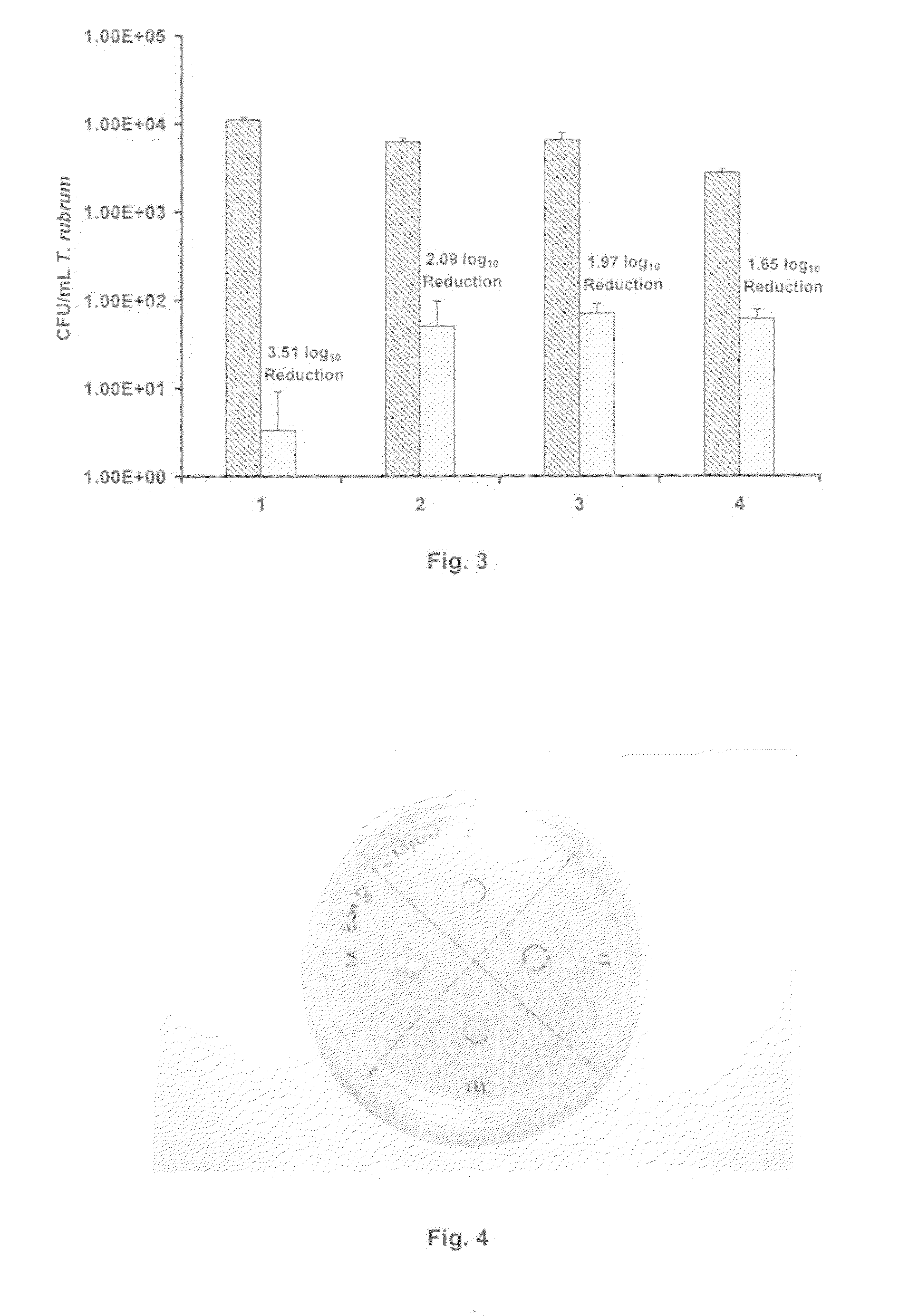Therapy and device for treatment of nail infections
a technology for nail infections and treatment, applied in the field of nail infections, can solve the problems of inability to effectively treat the infection, and inability to achieve the effect of sufficient penetration tim
- Summary
- Abstract
- Description
- Claims
- Application Information
AI Technical Summary
Benefits of technology
Problems solved by technology
Method used
Image
Examples
example i
[0074]An in vitro experiment was conducted by filling half (48 wells) of a 96 well plate with 100 μl of inoculums in each of the 48 wells and the other half (48 wells) with 100 μl of Periowave® photosensitizer solution, manufactured by Ondine Biopharma Corporation located in Vancouver, Canada containing about 0.01% w / v of methylene blue, in each of the 48 wells. Thereafter, 100 μl of a solution containing Trichophyton rubrum was also added to each of the 96 wells on such plate. Light at 670 nm provided by a 220 mW laser was applied to all of the 96 wells on such plate for 60 seconds. During all of the steps described above, the solutions within the wells were magnetically stirred. The wells containing the inoculums acted as the control group. This experiment was repeated four times and data as shown in FIG. 3 was expressed as viable fungal colonies of Trichophyton rubrum after treatment relative to control. In FIG. 3, the horizontal scale shows the number of experiments (i.e., 4) wi...
example ii
[0075]Another in vitro experiment was conducted by dividing each agar plate appropriate for fungal growth into four sections. All four sections were then inoculated with Trichophyton rubrum each in a 7 mm diameter circle. Sections, I, II, and III (starting from top going clockwise) were then exposed to 25 μl of Periowave® photosensitizer solution described in Experiment I and irradiated with a fiber-optically coupled laser at 600 mW for 60 seconds. After the light treatment, the agar plates were incubated at 37° C. to observe fungal growth. Trichophyton rubrum growth in treated Sections I, II, and III was then compared to growth in the untreated control Section IV on each of the agar plates. FIG. 4 showed one of the agar plates after 72 hours of incubation. FIG. 5 showed another one of the agar plates after 96 hours of incubation. FIG. 6 showed another one of the agar plates after 144 hours of incubation. FIG. 7 showed another one of the agra plates after about 9 days of incubation....
example iii
[0076]An exemplary protocol for the therapy for treatment of onychomycosis is as follows: Apply Toenail Soft™ or any of the above-discussed nail penetration enhancer to the nail beneath which the locus is situated and to leave it on the nail for 6 to 24 hours. Thereafter, apply the antifungal composition of the present invention containing the photosensitizer to the nail and leave it on the nail for about 15 minutes to about 24 hours. Thereafter, irradiating the locus by applying light to the nail at a wavelength absorbed by the photosensitizer of the antifungal composition so as to destroy microbes at the locus. After the irradiating the locus step, optionally apply a composition comprising the antifungal agent and the pharmaceutically acceptable delivery system wherein the pharmaceutically acceptable delivery system includes the pharmaceutically acceptable nail penetration enhancer; and repeat such application over a predetermined treatment period (e.g., days, weeks, or months).
PUM
| Property | Measurement | Unit |
|---|---|---|
| wavelength | aaaaa | aaaaa |
| wavelengths | aaaaa | aaaaa |
| wavelengths | aaaaa | aaaaa |
Abstract
Description
Claims
Application Information
 Login to View More
Login to View More - Generate Ideas
- Intellectual Property
- Life Sciences
- Materials
- Tech Scout
- Unparalleled Data Quality
- Higher Quality Content
- 60% Fewer Hallucinations
Browse by: Latest US Patents, China's latest patents, Technical Efficacy Thesaurus, Application Domain, Technology Topic, Popular Technical Reports.
© 2025 PatSnap. All rights reserved.Legal|Privacy policy|Modern Slavery Act Transparency Statement|Sitemap|About US| Contact US: help@patsnap.com



